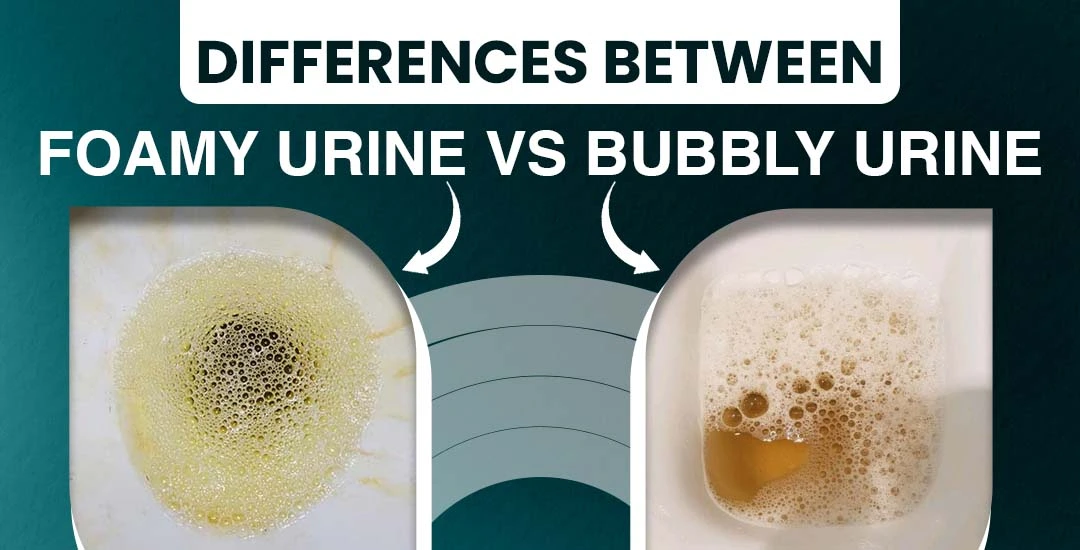
Foamy vs. Bubbly Urine: What’s the Real Difference
Let’s be honest; nobody really expects their bathroom trips to turn into a science experiment. But sometimes, as you stand there staring at your toilet bowl, you can’t help but notice: “Wait… are those bubbles… or is that foam? What the hell is foamy or bubbly urine?
Cue the dramatic background music. Because now your inner Sherlock Holmes kicks in, and suddenly, you’re analyzing your pee like it's evidence from a crime scene. Let’s check the differences between foamy urine vs bubbly urine in detail in this article.
The Tale of the Toilet: Bubbles vs. Foam
First, let’s get our basics right.
Normal urine bubbles are usually those big, innocent, floating air pockets that vanish quicker than your paycheck after online shopping. They’re often just caused by the speed of urination (a strong pee-stream can be a real bubble machine).
Foam in urine, on the other hand, is like the latte froth of the bathroom world; it sticks around, clings to the surface, and doesn’t just disappear in seconds. Foamy urine can sometimes signal protein leakage from your kidneys.
So yes, bubbles are your bathroom’s equivalent of a champagne pop, while foam is more like cappuccino froth.
Why Do Bubbles Happen?
Picture this: You’ve been holding your pee after binge-watching three episodes in a row. By the time you sprint to the bathroom, the pee pressure is high enough to power a small water fountain. That gush of urine hitting the toilet water creates, you guessed it, bubbles! Some of the common causes of bubbles in urine are:
Dehydration: Concentrated urine can be bubbly.
Cleaning agents in the toilet: Yep, sometimes your soap residue is just auditioning for a bubble show.
Random air in the urinary tract: Not common, but possible.
Most of the time, bubbles are harmless. They’re just physics and bladder enthusiasm teaming up.
Why Does Foam Show Up?
Foam is a little different. Imagine pouring beer into a glass too fast; it froths and hangs around. That’s kind of what happens when protein sneaks into your urine. Protein lowers surface tension, creating that foamy look. Some other factors causing foam can be:
Dehydration: Thick urine loves to foam.
Speed-peeing: A powerful pee-stream can whip up foam like a mini bathroom blender.
Soap/cleaners: Again, don’t blame your kidneys when it’s Mr. Clean doing the foaming.
But if you’re noticing persistent foamy urine, that’s when you should check in with a doctor. Because it can be an early signal of proteinuria (protein in urine) that is commonly associated with kidney disease.
Symptoms of Foamy Urine
- Urine looks bubbly or frothy
- Persistent foam even after flushing
- May appear thicker than normal urine (not always though)
Causes of Foamy Urine
- Fast or forceful urination
- Dehydration
- High protein in urine (proteinuria)
- Kidney problems
- Urinary tract infection (UTI)
- Certain medications or supplements
Differences Between Foamy Urine Vs Bubbly Urine
Here is an easy way to remember the difference:
Bubbles: They pop, and they are gone, just like that, within seconds. They are like a party guest that comes by, eats a chip, and then they are gone!
Foam: It lingers. Think of it as that one relative who comes over “just for dinner” but is still on your couch three days later.
So, one of the major differences between foamy urine vs bubbly urine is duration. If your toilet shows signs of vanishing fast, relax. If it sticks around, maybe don’t ignore it.
Should You Worry?
Let’s be real. Nobody wants to schedule a doctor’s appointment to say, “Uh, doc… I think my pee looks like a Starbucks latte.” But sometimes, it’s worth it.
You ought to consult a medical professional for possible kidney issues if:
* The foamy urine is constant and not a one-time event
* You also have swelling of the feet, hands, or face (could be fluid retention)
* You are urinating more often (or less) than usual
* You have other symptoms such as fatigue, nausea, or unexplained weight loss or gain.
Because while bubbly urine usually is harmless, foamy urine may point to the fact that your kidneys need a little care and prevention. Opting for an early treatment for foamy urine can help you completely cure this renal issue.
Home Remedies for Foamy Urine
Some good remedies for this renal issue are:
1. Stay Hydrated: Drink enough water.
2. Don’t Hold It Forever: Urinate regularly to avoid too much foaminess.
3. Check the Toilet: Make sure you thoroughly clean the pot.
4. Eat Kidney-Friendly Foods: Too much protein in your diet can add strain on your kidneys. Opt for plant-based protein, if possible!
Conclusion
So, the differences between foamy urine vs bubbly urine is pretty simple:
Bubbles = fast, fleeting, no big deal.
Foam = lingering, maybe a red flag.
Bubbles aren’t really something to be concerned about, but persistent foam is. The important thing? Don’t panic at the sight of one foamy flush, but also don’t ignore it if it keeps happening.
At the end of the day, your bathroom is a weirdly reliable health check-up room. So next time you’re in there, you can confidently tell yourself: “Relax, those are just bubbles. Foam, though… I’ll keep an eye on you.”
FAQ
Q1. What’s the difference between foamy urine and bubbly urine?
Foamy urine is much like soap suds and lasts longer, often linked to a higher concentration of protein in urine. Bubbly urine is just air bubbles from fast urination and disappears quickly.
Q2. How much foam in urine is normal?
A little foam that clears quickly is normal.
